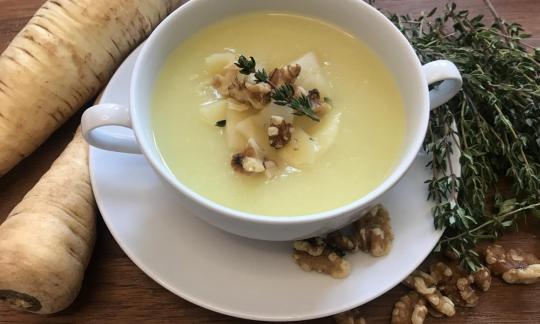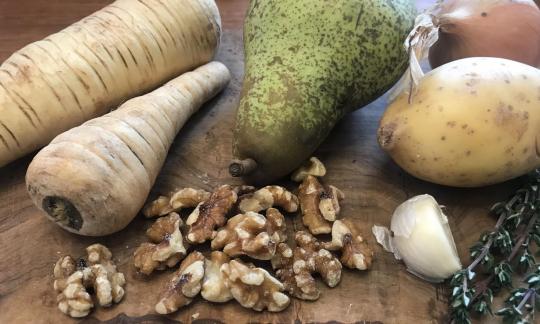Parsnip soup with pear, thyme and walnuts
vegan
Ingredients (for servings, )
| ½ | Onions, raw (organic?) (1.9 oz) |
| 1 clove | Garlic (organic?) (0.11 oz) |
| 2 sprigs | Thyme, raw (organic?) (0.13 oz) |
| 7 ⅓ oz | Parsnips, raw (organic?) |
| 1 | Potatoes, raw (organic?) (3.2 oz) |
| ½ | Pears, raw (organic?) (3.1 oz) |
| 400 ml | Drinking water, raw (organic?) (14 oz) |
| ⅔ oz | Walnuts (tree nuts), raw (organic?) |
Equipment
- hand-held blender / immersion blender
- steamer basket
- vegetable peeler
- skillet (frying pan)
- stove
- saucepan
Type of preparation
- chop or grind
- steam
- sweat
- purée
- remove the skin
- peel
- slice
Preparation
Preparation
Peel the onion and garlic and cut into fine cubes. Sauté together with the thyme in a non-stick pan without oil (add a little water if necessary). As soon as the onions are cooked, put the pan aside.You will need the thyme for the topping, so don't throw it away.
Peel the potatoes and cut into small pieces. Peel the parsnips and cut half of them into thumb-sized pieces. Steam them together with the potato pieces in a steamer for about 10 minutes. Alternatively, you can also boil the vegetables in a little water.
We used a medium-sized potato that weighed 70 grams for 2 portions. Chopping it reduces the cooking time.
Use a vegetable peeler to slice the remaining parsnips into thin slices. If the parsnips are large, halve or quarter them again. Set the parsnip slices aside for the next step.
For the topping
Remove the core of the pear and cut the pear into cubes. Sauté together with the parsnip slices and the thyme from step 1 for about 5-8 minutes (add a few tablespoons of water if too dry). Remove the thyme sprigs and, depending on your taste, strip the leaves from the stems and add them back to the pear.
Roughly chop the walnuts.Finishing the soup
Puree the cooked parsnips and potatoes from step 2 with the water and bring to the boil briefly. Pour the hot soup into bowls and serve with the thyme pears and walnuts as a topping.
|
Nutritional Information per person
Convert per 100g
|
2000 kcal | |
|---|---|---|
| Energy | 216 kcal | 10.8% |
| Fat/Lipids | 7.0 g | 10.0% |
| Saturated Fats | 0.70 g | 3.5% |
| Carbohydrates (inc.dietary fiber) | 38 g | 13.9% |
| Sugars | 11 g | 12.2% |
| Fiber | 8.7 g | 34.6% |
| Protein/Albumin | 4.3 g | 8.6% |
| Cooking Salt (Na:22.9 mg) | 58 mg | 2.4% |
| Essential micronutrients with the highest proportions | per person | 2000 kcal | |
|---|---|---|---|
| Min | Manganese, Mn | 1.1 mg | 54.0% |
| Vit | Folate, as the active form of folic acid (née vitamin B9 and | 93 µg | 46.0% |
| Fat | Alpha-Linolenic acid; ALA; 18:3 omega-3 | 0.93 g | 46.0% |
| Vit | Vitamin C (ascorbic acid) | 33 mg | 42.0% |
| Min | Copper, Cu | 0.41 mg | 41.0% |
| Fat | Linoleic acid; LA; 18:2 omega-6 | 3.9 g | 39.0% |
| Elem | Potassium, K | 719 mg | 36.0% |
| Vit | Vitamin K | 26 µg | 34.0% |
| Vit | Vitamin B6 (pyridoxine) | 0.35 mg | 25.0% |
| Elem | Phosphorus, P | 149 mg | 21.0% |
Detailed Nutritional Information per Person for this Recipe
The majority of the nutritional information comes from the USDA (US Department of Agriculture). This means that the information for natural products is often incomplete or only given within broader categories, whereas in most cases products made from these have more complete information displayed.
If we take flaxseed, for example, the important essential amino acid ALA (omega-3) is only included in an overarching category whereas for flaxseed oil ALA is listed specifically. In time, we will be able to change this, but it will require a lot of work. An “i” appears behind ingredients that have been adjusted and an explanation appears when you hover over this symbol.
For Erb Muesli, the original calculations resulted in 48 % of the daily requirement of ALA — but with the correction, we see that the muesli actually covers >100 % of the necessary recommendation for the omega-3 fatty acid ALA. Our goal is to eventually be able to compare the nutritional value of our recipes with those that are used in conventional western lifestyles.
| Essential fatty acids | per person | 2000 kcal |
|---|---|---|
| Alpha-Linolenic acid; ALA; 18:3 omega-3 | 0.93 g | 46.0% |
| Linoleic acid; LA; 18:2 omega-6 | 3.9 g | 39.0% |
| Essential amino acids | per person | 2000 kcal |
|---|---|---|
| Tryptophan (Trp, W) | 0.03 g | 14.0% |
| Threonine (Thr, T) | 0.11 g | 11.0% |
| Isoleucine (Ile, I) | 0.11 g | 9.0% |
| Valine (Val, V) | 0.14 g | 9.0% |
| Leucine (Leu, L) | 0.19 g | 8.0% |
| Phenylalanine (Phe, F) | 0.12 g | 8.0% |
| Lysine (Lys, K) | 0.12 g | 6.0% |
| Methionine (Met, M) | 0.04 g | 4.0% |
| Vitamins | per person | 2000 kcal |
|---|---|---|
| Folate, as the active form of folic acid (née vitamin B9 and | 93 µg | 46.0% |
| Vitamin C (ascorbic acid) | 33 mg | 42.0% |
| Vitamin K | 26 µg | 34.0% |
| Vitamin B6 (pyridoxine) | 0.35 mg | 25.0% |
| Thiamine (vitamin B1) | 0.18 mg | 17.0% |
| Pantothenic acid (vitamin B5) | 0.86 mg | 14.0% |
| Vitamin E, as a-TEs | 1.6 mg | 14.0% |
| Biotin (ex vitamin B7, H) | 4.9 µg | 10.0% |
| Niacin (née vitamin B3) | 1.4 mg | 9.0% |
| Riboflavin (vitamin B2) | 0.11 mg | 8.0% |
| Vitamin A, as RAE | 4.9 µg | 1.0% |
| Essential macroelements (macronutrients) | per person | 2000 kcal |
|---|---|---|
| Potassium, K | 719 mg | 36.0% |
| Phosphorus, P | 149 mg | 21.0% |
| Magnesium, Mg | 66 mg | 18.0% |
| Calcium, Ca | 78 mg | 10.0% |
| Sodium, Na | 23 mg | 3.0% |
| Essential trace elements (micronutrients) | per person | 2000 kcal |
|---|---|---|
| Manganese, Mn | 1.1 mg | 54.0% |
| Copper, Cu | 0.41 mg | 41.0% |
| Iron, Fe | 1.7 mg | 12.0% |
| Zinc, Zn | 1.2 mg | 12.0% |
| Selenium, Se | 2.9 µg | 5.0% |
| Fluorine, F | 144 µg | 4.0% |
| Iod, I (Jod, J) | 2.4 µg | 2.0% |
The parsnip soup with pear, thyme and walnuts does not require any salt or oil thanks to the spicy ingredients.
Portion information: The specified amount of 2 portions is sufficient for 2 main courses or 4 starters.
Nutrient profile: One portion of this recipe covers more than 50% of the average daily requirement of manganese, which plays a role in the formation of cartilage tissue, among other things. Omega-3 fatty acids and folic acid are half covered. The ratio of omega-6 to omega-3 fatty acids is 4:1, which is below the maximum recommended ratio of 5:1. More on this under: Vegans often eat unhealthily. Avoidable nutritional errors.
Parsnip: The parsnip has a sweet, spicy, sometimes bitter taste. Parsnips are similar to parsley root, but have a milder taste. They not only stimulate the appetite, but also have a diuretic effect.
Pears: Pears ( Pyrus communis) contain, among other things, small amounts of folic acid, copper, vitamin C, potassium and vitamin K. Thanks to their low acid content, they are easier to digest than apples and, like apples, stimulate digestion.
Thyme: Thyme is not only used as a spice, but also for colds and bronchitis. It has anti-inflammatory, antiseptic, expectorant and stimulates the immune system.
Walnut: The real walnut, also called tree nut, has the highest content of linolenic acid (an omega-3 fatty acid that is healthy for the heart) of all nuts. It is also rich in vitamin E, zinc (an important trace element for the liver and hair, among other things) and potassium.
Reduce salt and oil: We have deliberately left out salt and oil for health reasons. The seasoning of the ingredients alone gives the soup an intense taste. You can find more information on this topic in the book we describe in detail: "Salt Sugar Fat" by Michael Moss.
If you don't have a steamer at home, you can also boil the parsnips and potatoes.
Seasoning: Optionally, you can season the soup with a dash of white wine or the addition of salt.






